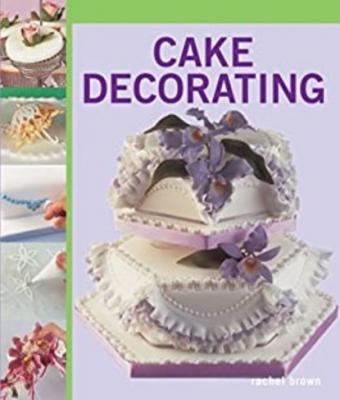Cake Decorating. Rachel Brown
Чтение книги онлайн.
Читать онлайн книгу Cake Decorating - Rachel Brown страница 2
 sizes and colours
sizes and colours
2 Non-stick rolling pin – these are worth the money because they are so useful
3 Balling/bone tool – used for giving your flowers movement
4 Veining tool – the ideal tool for putting veins on sugar flowers
5 Small sharp scissors
6 Arum lily cutter – these come in a wide selection of sizes; several sizes are used throughout the book, but the tiny ones can be seen on page 84
7 Sugar glue – this can be bought ready-made or made at home
8 Coloured semolina – just mix food dust in with the semolina to colour it; it is so useful for so many flowers. Store in a small pot so you can use it when required; it keeps for a long time
9 Plunger blossom cutters – available in a few makes, but the PME range comes in a huge number of sizes
10 Small and medium calyx cutters
11 Palette knife (metal spatula) – a crank-handled (angled) one is preferable. It helps you lift your fine paste work
12 Sugar craft wires – they come in a variety of sizes. The higher the number, the thinner the wire. Available in greens and white.
13 Dry flower oasis can be purchased from any hobby store or florist. Cover it in cling film (plastic wrap) to prevent bits breaking off and getting on your cake work
14 Florist tape – in a number of different colours
15 Veiner – to give each leaf a realistic, natural look
• Balling mat – you place your cut-out flower shape on this to ball it
• Non-stick small stick – this is useful for the small delicate work
• Daisy cutters – there are so many on the market to choose from, all giving different effects. I use the Orchard product range, but the FMM Daisy collection set is excellent as well – it just gives finer petals
• Plastic cocktail sticks (toothpicks) – try to get plastic as you don’t want the splinters the wooden ones may leave behind
• Small paintbrush for applying sugar glue
• Large flat dusting brush, to dust your flowers with
• five-petal blossom cutter – available in a vast array of sizes so you can vary the size of your work
• Food dusts and food paste colours – build up a collection of colours as you take on more work
• Small amount of white vegetable fat (vegetable shortening) – keep it in a small tub with your equipment
• Stamens – artificial flower stamens made from stiffened cotton come in a vast array of colours and are available from sugar craft shops
It really is worth buying good-quality metal equipment as it will give a much better result. These tools should last a lifetime if they are looked after properly. Keep them wrapped up between uses to keep them from getting scratched.
cake boards
Use a cake board that is at least 7.5cm (3in) larger than your cake to give it the best effect when finished. It is visually pleasing to ice the board and carry the design from the cake on to the board.
If you follow the collar design (see page 73), then you will need to make sure that your board is a minimum of 10cm (4in) larger than your cake. It would be terrible if you completed your cake with your collar looking beautiful, only for it to get broken as it overhangs the board.
making a piping bag
method
1 To make a piping (decorating) bag, cut some greaseproof (waxed) paper into an equilateral triangle.
2 Pick up corner C and fold it over to the dotted line, so that a sharp cone shape forms at B.
3 Wrap corner A around the cone.
4 Make sure A and C are at the back of the cone and that the point of the cone is sharp.
5 Fold points A and C inside the top edge of the bag to hold it securely. Snip off the end of B and insert a piping tube (nozzle).
advice
• Always use a good-quality greaseproof (waxed) or parchment paper to create a good strong bag. If you use a selection of different-sized equilateral triangles and make up a quantity of piping (decorating) bags, you will always have a bag suitable for every job.
• You can buy piping bags instead of making your own. There are both reusable nylon piping bags and disposable paper piping bags available on the market. Choose whatever you find comfortable. The advantage of the reusable piping bag is that you can change the tube (nozzle) without having to empty the bag. You simply unscrew the adaptor and swap your tube. They are good for when you are piping a large area or a border. The paper bags are better for the delicate work, but go with what you feel comfortable with to achieve the best results.
inserting piping tubes
• When it comes to inserting a piping tube (nozzle), make sure that you cut only the very end off the bag (as shown in diagram 5 opposite), so that when your tube goes into the bag at least three-quarters of it is inside the bag and only one-quarter is showing. The more you have showing, the more likely it is that your bag will split when you start piping by putting pressure on the bag.
• Avoid the cheap plastic or poor-quality metal tubes as they bend and change shape so easily and do not give such a good finish. When you want to do fine delicate work, you really need a good-quality nozzle. The metal PME tubes are seamless and excellent quality, so you will find your tube